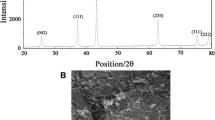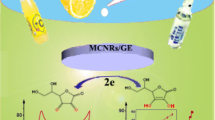Abstract
In this work, a simple and rapid electrochemical method is presented for the voltammetric determination of histamine based on carbon paste electrodes bulk-modified with single-walled carbon nanotubes. As monitored in cyclic voltammetry histamine undergoes an irreversible electrochemical oxidation with a peak potential of ca. +1.25 V (vs. Ag/AgCl, 3 mol L−1 KCl) in phosphate buffer solution (PBS, 0.1 mol L−1, pH 6.0). At optimized differential pulse voltammetric parameters, the current response of histamine was linearly proportional to its concentration in the range from 4.5 to 720 μmol L−1. A low limit of detection of 1.26 μmol L−1 and a limit of quantification of 3.78 μmol L−1 of histamine, as well as good reproducibility (RSD = 0.48–3.40 %) were obtained using the carbon paste electrode modified with single-walled carbon nanotubes. The proposed sensor was successfully applied to the determination of histamine in commercial beer and wine samples.






Similar content being viewed by others
References
Antiochia R, Lavagnini I, Magno F, Valentini F, Palleschi G (2004) Single-wall carbon nanotube paste electrodes: a comparison with carbon paste, platinum and glassy carbon electrodes via cyclic voltammetric data. Electroanalysis 16:1451–1458
Antoine FR, Wei C, Steve Otwell W, Sims CA, Littell RC, Hogle AD, Marshall MR (2002) Gas chromatography analysis of histamine in mahi-mahi. J Agric Food Chem 50:4754–4759
AOAC (2002) Official method of analysis of AOAC International, 17th edn. AOAC International, Maryland
Bao L, Sun D, Tachikawa H, Davidson VL (2002) Improved sensitivity of a histamine sensor using an engineered methylamine dehydrogenase. Anal Chem 74:1144–1148
Bauza T, Blaise A, Daumas F, Cabanis J (1995) Determination of biogenic amines and their precursor amino acids in wines of the Vallée du Rhone by high-performance liquid chromatography with precolumn derivatization and fluorimetric detection. J Chromatogr A 707:373–379
Degefu H, Amare M, Tessema M, Admassie S (2014) Lignin modified glassy carbon electrode for the electrochemical determination of histamine in human urine and wine samples. Electrochim Acta 121:307–314
Fernandes JO, Judas IC, Oliveira MB, Ferreira IMPLVO, Ferreira MA (2001) A GC-MS method for quantitation of histamine and other biogenic amines in beer. Chromatographia 53:S327–S331
Geto A, Tessema M, Admassie S (2014) Determination of histamine in fish muscle at multi-walled carbon nanotubes coated conducting polymer modified glassy carbon electrode. Synth Met 191:135–140
Hwang B-S, Wang J-T, Choong Y-M (2003) A rapid gas chromatographic method for the determination of histamine in fish and fish products. Food Chem 82:329–334
ICH-Q2B (1996) Validation of analytical procedures: methodology Q2 (R1). International Conference on Harmonisation. Validation of Analytical Procedures: Text and Methodology, ICH, Geneva, Switzerland. http://www.gmp-compliance.org/guidemgr/files/Q2(R1).PDF (1.9.2015)
Jensen TB, Marley PD (1995) Development of an assay for histamine using automated high-performance liquid chromatography with electrochemical detection. J Chromatogr B 670:199–207
Jutel M, Watanabe T, Akdis M, Blaser K, Akdis CA (2002) Immune regulation by histamine. Curr Opin Immunol 14:735–740
Kalcher K (1990) Chemically modified carbon paste electrodes in voltammetric analysis. Electroanalysis 2:419–433
Karimi-Maleh H, Biparva P, Hatami M (2013) A novel modified carbon paste electrode based on NiO/CNTs nanocomposite and (9, 10-dihydro-9, 10-ethanoanthracene-11, 12-dicarboximido)-4-ethylbenzene-1, 2-diol as a mediator for simultaneous determination of cysteamine, nicotinamide adenine dinucleotide and folic acid. Biosens Bioelectron 48:270–275
Karimi-Maleh H, Tahernejad-Javazmi F, Ensafi AA, Moradi R, Mallakpour S, Beitollahi A (2014) A high sensitive biosensor based on FePt/CNTs nanocomposite/N-(4-hydroxyphenyl)-3,5-dinitrobenzamide modified carbon paste electrode for simultaneous determination of glutathione and piroxicam. Biosens Bioelectron 60:1–7
Karimi-Maleh H, Tahernejad-Javazmi F, Atar N, Yola ML, Gupta VK, Ensafi AA (2015) A novel DNA biosensor based on a pencil graphite electrode modified with polypyrrole/functionalized multiwalled carbon nanotubes for determination of 6-mercaptopurine anticancer drug. Ind Eng Chem Res 54:3634–3639
Keow CM, Bakar FA, Salleh AB, Heng LY, Wagiran R, Bean LS (2007) An amperometric biosensor for the rapid assessment of histamine level in tiger prawn (Penaeus monodon) spoilage. Food Chem 105:1636–1641
Laviron E (1979) General expression of the linear potential sweep voltammogram in the case of diffusionless electrochemical systems. J Electroanal Chem 101:19–28
Lehane L, Olley J (2000) Histamine fish poisoning revisited. Int J Food Microbiol 58:1–37
Libo N, Huishi G, Quanguo H, Jianrong C, Yuqing M (2007) Enhanced electrochemical detection of DNA hybridization with carbon nanotube modified paste electrode. J Nanosci Nanotechnol 7:560–564
Lieber ER, Taylor SL (1978) Thin-layer chromatographic screening methods for histamine in tuna fish. J Chromatogr A 153:143–152
Lonvaud-Funel A (2001) Biogenic amines in wines: role of lactic acid bacteria. FEMS Microbiol Lett 199:9–13
Maintz L, Novak N (2007) Histamine and histamine intolerance. Am J Clin Nutr 85:1185–1196
Male KB, Bouvrette P, Luong JHT, Gibbs B (1996) Amperometric biosensor for total histamine, putrescine and cadaverine using diamine oxidase. J Food Sci 61:1012–1016
Najafi M, Khalilzadeh MA, Karimi-Maleh H (2014) A new strategy for determination of bisphenol A in the presence of Sudan I using a ZnO/CNTs/ionic liquid paste electrode in food samples. Food Chem 158:125–131
Niculescu M, Frébort I, Peč P, Galuszka P, Mattiasson B, Csöregi E (2000) Amine oxidase based amperometric biosensors for histamine detection. Electroanalysis 12:369–375
Önal A (2007) A review: current analytical methods for the determination of biogenic amines in foods. Food Chem 103:1475–1486
Patange SB, Mukundan MK, Ashok Kumar K (2005) A simple and rapid method for colorimetric determination of histamine in fish flesh. Food Control 16:465–472
Proestos C, Loukatos P, Komaitis M (2008) Determination of biogenic amines in wines by HPLC with precolumn dansylation and fluorimetric detection. Food Chem 106:1218–1224
Rauscher-Gabernig E, Grossgut R, Bauer F, Paulsen P (2009) Assessment of alimentary histamine exposure of consumers in Austria and development of tolerable levels in typical foods. Food Control 20:423–429
Rivas GA, Rubianes MD, Pedano ML, Ferreyra NF, Luque GL, Rodríguez MC, Miscoria SA (2007) Carbon nanotubes paste electrodes. A new alternative for the development of electrochemical sensors. Electroanalysis 19:823–831
Russell FE, Maretić Z (1986) Scombroid poisoning: mini-review with case histories. Toxicon 24:967–973
Saleh Ahammad AJ, Lee J-J, Aminur Rahman M (2009) Electrochemical sensors based on carbon nanotubes. Sensors 9:2289–2319
Sarada BV, Rao TN, Tryk DA, Fujishima A (2000) Electrochemical oxidation of histamine and serotonin at highly boron-doped diamond electrodes. Anal Chem 72:1632–1638
Stojanović Z, Švarc-Gajić J (2011) A simple and rapid method for histamine determination in fermented sausages by mediated chronopotentiometry. Food Control 22:2013–2019
Švancara I, Kalcher K, Walcarius A, Vytras K (2012) Electroanalysis with carbon paste electrodes. CRC Press, Taylor & Francis Group, Boca Raton
Švarc-Gajić J, Stojanović Z (2010) Electrocatalytic determination of histamine on a nickel-film glassy carbon electrode. Electroanalysis 22:2931–2939
Švarc-Gajić J, Stojanović Z (2011) Determination of histamine in cheese by chronopotentiometry on a thin film mercury electrode. Food Chem 124:1172–1176
Tao Z, Sato M, Han Y, Tan Z, Yamaguchi T, Nakano T (2011) A simple and rapid method for histamine determination by TLC determination. Food Control 22:1154–2257
Taylor SL (1986) Histamine poisoning: toxicology and clinical aspects. Crit Rev Toxicol 17:91–128
Trojanowicz M (2006) Analytical applications of carbon nanotubes: a review. Trends Anal Chem 25:480–489
Valentini F, Amine A, Orlanducci S, Terranova ML, Palleschi G (2003) Carbon nanotube purification: preparation and characterization of carbon nanotube paste electrodes. Anal Chem 75:5413–5421
Wang J (2005) Carbon-nanotube based electrochemical biosensors: a review. Electroanalysis 17:7–14
Wang Z, Liu J, Liang Q, Wang Y, Luo G (2002) Carbon nanotube-modified electrodes for the simultaneous determination of dopamine and ascorbic acid. Analyst 127:653–658
Yamamoto K, Takagi K, Kano K, Ikeda T (2001) Bioelectrocatalytic detection of histamine using quinohemoprotein amine dehydrogenase and the native electron acceptor cytochrome c-550. Electroanalysis 13:375–379
Yilmaz UT, Inan D (2015) Quantification of histamine in various fish samples using square wave stripping voltammetric method. J Food Sci Technol 52:6671–6678
Zeng K, Tachikawa H, Zhu Z, Davidson VL (2000) Amperometric detection of histamine with a methylamine dehydrogenase polypyrrole-based sensor. Anal Chem 72:2211–2215
Zhang L-Y, Sun M-X (2004) Determination of histamine and histidine by capillary zone electrophoresis with pre-column naphthalene-2,3-dicarboxaldehyde derivatization and fluorescence detection. J Chromatogr A 1040:133–140
Acknowledgments
This work was supported by CEEPUS (Central European Exchange Program for University Studies) project CZ 0212. We have no financial relationship with the organization that sponsored the research. Z. S. acknowledges financial support from the Coimbra Group Universities through scholarship for short research stay at the Karl-Franzens University in Graz. E.M. acknowledges a scholarship from Higher KOS Stipendien, financed by ADA and MEST and the Austrian Agency for International Cooperation in Education and Research (OeAD-GmbH).
Author information
Authors and Affiliations
Corresponding author
Ethics declarations
Conflict of Interest
Zorica S. Stojanović declares that she has no conflict of interest. Eda Mehmeti declares that she has no conflict of interest. Kurt Kalcher declares that he has no conflict of interest. Valéria Guzsvány declares that she has no conflict of interest. Dalibor M. Stanković declares that he has no conflict of interest.
Ethical Approval
This article does not contain any studies with human or animal subjects. This is an original research article that has neither been published previously nor considered presently for publication elsewhere. All authors named in the manuscript are entitled to the authorship and have approved the final version of the submitted manuscript.
Informed Consent
Not applicable.
Rights and permissions
About this article
Cite this article
Stojanović, Z.S., Mehmeti, E., Kalcher, K. et al. SWCNT-modified carbon paste electrode as an electrochemical sensor for histamine determination in alcoholic beverages. Food Anal. Methods 9, 2701–2710 (2016). https://doi.org/10.1007/s12161-016-0452-3
Received:
Accepted:
Published:
Issue Date:
DOI: https://doi.org/10.1007/s12161-016-0452-3




